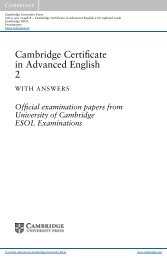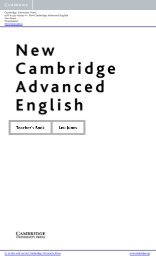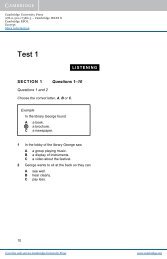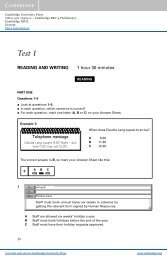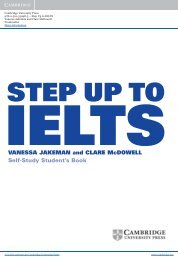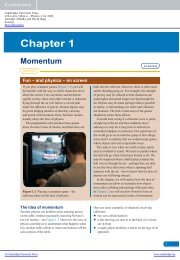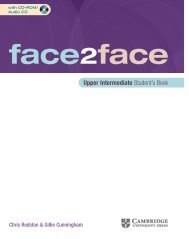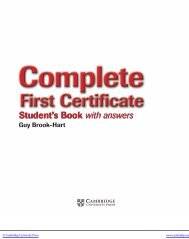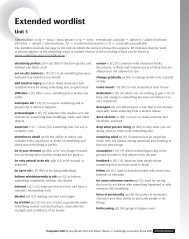Skills for Study Level 2 Teacher's Book - Cambridge University Press
Skills for Study Level 2 Teacher's Book - Cambridge University Press
Skills for Study Level 2 Teacher's Book - Cambridge University Press
You also want an ePaper? Increase the reach of your titles
YUMPU automatically turns print PDFs into web optimized ePapers that Google loves.
Herbal medicines are used widely within the UK (Benson et al., 2009). Indeed, asa recent study by Cox (2008) indicates, rising annual sales of herbal medicinessuggest that their popularity is on the increase. This popularity is probablydue to a number of factors: low price compared to the costs of conventionaldrugs (Cox, ibid); a popular notion that herbal treatments have fewer sideeffects (Lasky et al., 2005); and a growing interest in spiritual, traditional or‘holistic’ approaches to staying healthy which are not typically offered in themainstream medical system (Campbell & Ho, 2008). It seems, then, that peopleturn to herbal medicines and other similar treatments both because of typicalconsumer behaviour (sensitivity to cost and comparison of different products)as well as a rising attraction to ‘alternative’ lifestyle choices in the UK at large.2According to Quinn (2008), approximately 35% of the UK population willuse herbal remedies of some sort during their lifetime, either by visiting aherbal practitioner or by purchasing over-the-counter remedies in a shop.Numerous explanations have been given <strong>for</strong> the apparent popularity of theseremedies. Cox (2008) notes that the costs of herbal remedies are often farlower than conventional drugs (both in terms of monetary cost, and the timespent visiting a doctor to receive a prescription). However, there may be otherfactors involved besides cost. According to Fuller (1999), herbal remedieshave far fewer side effects than mainstream treatments. One study by Ponzioand Stewart (2004) suggests that this benign view of herbal medicines iswidespread among the general public, who may there<strong>for</strong>e be more inclined tochoose herbal medicines to treat less serious conditions. A further possibility<strong>for</strong> the widespread reliance on herbal medicines is suggested by Campbelland Ho (2008), who claim that herbal medicines fit in with a growing interest in‘alternative’ lifestyle choices in the UK. There is a growing interest in spirituality,alternative philosophies and fascination with ancient healing systems fromother nations such as India and China, and herbalism naturally falls into thatcategory of lifestyle choices.4dSuggested answers1 In 1) the writer seems more certain about the in<strong>for</strong>mation they have used,because they use non-integral citations throughout, implying agreement. In 2)the author has used integral citations and more cautious phrases to introducethe in<strong>for</strong>mation.2 Certain, because of the non-integral citation.3 This depends on the student. It is hard to say whether it is justified becauseno supporting evidence is presented. A reader could justly question whetherthe supporting sources were correct. (However, it might be worth pointingout that this type of unquestioned integral citation is more common – andappropriate – in the introductory section of an essay / report than it would bein a discussion section, <strong>for</strong> instance.) The use of more cautious language, andsupporting evidence, would help to make this more persuasive.Unit 3 Part C ∙ Investigating 91



